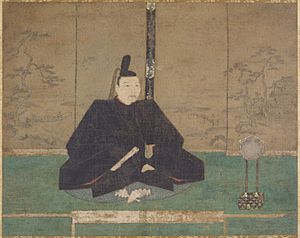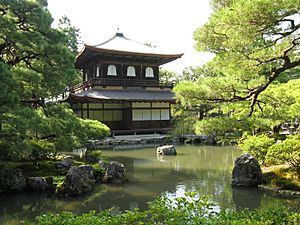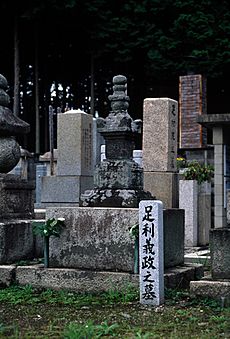Ashikaga Yoshimasa facts for kids
Quick facts for kids
Ashikaga Yoshimasa
足利 義政 |
|
|---|---|

Ashikaga Yoshimasa (painting attributed to Tosa Mitsunobu, latter half of 15th century)
|
|
| Shōgun | |
| In office 1449–1474 |
|
| Monarch | |
| Preceded by | Ashikaga Yoshikatsu |
| Succeeded by | Ashikaga Yoshihisa |
| Personal details | |
| Born | January 20, 1436 |
| Died | January 27, 1490 (aged 54) |
| Spouse | Hino Tomiko |
| Parents |
|
| Signature |  |
Ashikaga Yoshimasa (足利 義政, January 20, 1436 – January 27, 1490) was the eighth shōgun of the Ashikaga shogunate. He ruled Japan from 1449 to 1473 during the Muromachi period. A shōgun was a powerful military leader who ruled Japan for the emperor.
Contents
Ashikaga Yoshimasa's Life
Yoshimasa was born on January 20, 1436. His father was Ashikaga Yoshinori, who was the sixth shōgun. Yoshimasa's childhood name was Miharu. His main wife was Hino Tomiko.
Yoshimasa became shōgun when he was young. His older brother, Yoshikatsu, had been shōgun before him. But Yoshikatsu died at age 10 after falling from a horse. This happened on August 16, 1443. So, Yoshimasa became the new shōgun at a very young age. He later changed his name from Yoshinari to Yoshimasa.
Yoshimasa's Family
- Father: Ashikaga Yoshinori
- Mother: Hino Shigeko (1411–1463)
- Wife: Hino Tomiko
- Children with Hino Tomiko:
- A son born in 1459 (who died young)
- Ashikaga Yoshihisa
- A daughter (1463–1486)
- Koyama Masatoshi (1462–1505), who became a Buddhist priest
- Adopted sons:
Events During Yoshimasa's Rule
Many important things happened while Yoshimasa was shōgun. These events shaped Japan's history.
- 1443: Supporters of the Southern Court stole the Imperial Regalia of Japan. These were special items that showed the emperor's power.
- 1449: Yoshimasa officially became shōgun.
- 1450–1455: There were problems in Kamakura. This was a city where another important leader, the Kantō kubō, lived.
Problems Leading to War
Several disagreements and conflicts eventually led to a big civil war.
- 1454: There was a fight over who would lead the Hatakeyama family.
- 1455: More arguments happened in Kamakura. This led to the creation of the "Koga Kubō" group.
- 1458: The stolen Imperial Regalia were returned to the Northern Court.
- 1460: The Hatakeyama family rebelled against Yoshimasa.
- 1464: Yoshimasa adopted his younger brother, Ashikaga Yoshimi, as his heir. He did this because he didn't have a son yet.
- 1466: Yoshimasa's own son, Ashikaga Yoshihisa, was born. This created a big problem. Who would be the next shōgun?
- 1467: The Ōnin War began.
The Ōnin War
The Ōnin War was a major civil war in Japan. It started because of a fight over who would be the next shōgun.
Yoshimasa had adopted his brother Yoshimi as his heir. But then his son, Yoshihisa, was born. Yoshimasa's wife, Hino Tomiko, wanted her son Yoshihisa to be the next shōgun. This caused a big disagreement between the two brothers.
Powerful Japanese lords, called daimyōs, took sides in this fight. This led to a huge armed conflict in 1467. The Ōnin War marked the start of the Sengoku period. This was a long time in Japanese history with many military battles.
- 1468: Yoshimi joined forces with Yamana Sōzen, one of the powerful daimyō leaders.
- 1469: Yoshihisa was officially named the heir to the shogunate.
- 1473: The main leaders of the two warring sides, Yamana Sōzen and Hosokawa Katsumoto, both died.
Yoshimasa retired in 1473, even though the war was still going on. He gave the title of shōgun to his young son, Yoshihisa. But Yoshimasa still held much of the real power. With the main leaders of the war gone, the fighting slowly stopped. By 1477, the Ōnin War was over.
Yoshimasa's Heirs and Later Years
Yoshimasa expected his son Yoshihisa to rule after him. But Yoshihisa died too soon. So, Yoshimasa had to take back power again.
Yoshimasa then adopted another nephew, Ashikaga Yoshitane. In 1489, Yoshitane became the new shōgun. Yoshimasa retired for a second time.
Yoshimasa died in 1490 at the age of 56. Before he died, he adopted another nephew, the son of his brother Masatomo. This nephew later became shōgun Ashikaga Yoshizumi.
After Yoshimasa, the shogunate was led by:
- His natural son, Yoshihisa.
- His first adopted son, Yoshitane.
- His second adopted son, Yoshizumi.
Higashiyama Culture
During Yoshimasa's time, a special type of culture grew in Japan. It was called the Higashiyama culture (Higashiyama bunka). This culture was famous for many art forms:
- Tea ceremony (Sadō)
- Flower arrangement (Kadō or Ikebana)
- Noh drama (a type of Japanese musical theater)
- Indian ink painting
Higashiyama culture was greatly influenced by Zen Buddhism. It also saw the rise of Japanese ideas about beauty, like Wabi-sabi. This idea finds beauty in things that are imperfect or simple. This period also blended the culture of the imperial court with the culture of the samurai warriors.
Important Dates for Higashiyama Culture
- 1459: Shōgun Yoshimasa helped repair the Atsuta Shrine. He provided new items for its festival.
- 1460: Yoshimasa started planning to build a special villa and gardens for his retirement. After he died, this place became a Buddhist temple called Jishō-ji. It is also known as Ginkaku-ji, or the "Silver Pavilion."
- February 21, 1482: Construction of the "Silver Pavilion" began.
- January 27, 1490: Yoshimasa died. His death marked the beginning of the end for the Higashiyama culture period.
Eras of Yoshimasa's Rule
The years when Yoshimasa was shōgun are known by several different era names or nengō. These are like different time periods within his rule.
- Hōtoku (1449–1452)
- Kyōtoku (1452–1455)
- Kōshō (1455–1457)
- Chōroku (1457–1460)
- Kanshō (1460–1466)
- Bunshō (1466–1467)
- Ōnin (1467–1469)
- Bunmei (1469–1487)
- Chōkyō (1487–1489)
- Entoku (1489–1492)
See Also
 In Spanish: Ashikaga Yoshimasa para niños
In Spanish: Ashikaga Yoshimasa para niños



